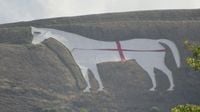On the morning of September 9, 2025, residents of Wiltshire, England, woke to a startling sight: the ancient Westbury White Horse, a colossal chalk figure carved into the hillside, had been transformed overnight into a giant England flag. Red fabric, carefully draped in the unmistakable shape of the St George’s cross, stretched across the 175-foot (53-meter) landmark, its brilliant color sharply contrasting with the iconic white chalk beneath.
The transformation was more than just a bold visual statement. According to BBC Wiltshire, the fabric was secured using pegs driven into the ground around the horse’s outline. The installation, though temporary, quickly drew the attention—and concern—of local authorities and heritage organizations. By the afternoon, the fabric had been removed after being reported to English Heritage, the organization responsible for protecting some of the UK’s most treasured historical sites.
English Heritage responded promptly to the incident. After inspecting the site, the organization concluded that the pegs used to anchor the fabric had caused only “minimal damage” to the monument. However, even minor alterations to such a landmark can carry significant consequences. The Westbury White Horse is not just a local curiosity—it’s a scheduled monument, protected by strict legislation. As BBC Wiltshire noted, it is a criminal offence to damage the site, and deliberate harm or removal of items from such monuments can result in heavy fines or even prison sentences.
In the immediate aftermath, Wiltshire Police initially stated they would not be investigating the incident. But after English Heritage’s assessment, the police reversed course. “We have received a report regarding minor damage being done to the horse through the use of pegs,” a police spokesperson told BBC Wiltshire. “We are in the early stages of our inquiries.” As of September 16, 2025, the investigation remains ongoing, with police gathering information and assessing whether further action is warranted.
The stunt comes at a time of heightened national pride. Over the past several months, thousands of St George’s flags have appeared across England, draped from windows, hung in pubs, and flown at sporting events. The appearance of the giant flag on the hillside seems to be part of this broader wave of patriotic displays, though it has sparked a debate about how far such expressions should go—especially when they involve protected historical sites.
The Westbury White Horse itself is steeped in history and local lore. It is believed to have been originally carved in 878 AD, commemorating King Alfred’s legendary victory over the Danes at the Battle of Ethandune. Over the centuries, the horse has become a symbol of the county and a cherished landmark for locals and visitors alike. Its stark white form, set against the rolling green hills of Wiltshire, is visible for miles and has inspired countless artists, writers, and historians.
For many, the transformation of the horse into an England flag was an audacious act—one that captured the spirit of the times but also raised important questions about the protection of cultural heritage. “We understand the desire to celebrate national symbols,” said an English Heritage representative, “but it’s vital that our historic sites are respected and preserved for future generations.”
The incident has ignited discussion not just about the monument itself, but about the broader responsibilities of those who seek to make public statements using shared spaces. Some locals expressed admiration for the creativity and scale of the stunt, while others voiced concern about setting a precedent for similar acts that could cause more serious damage. “It’s one thing to fly a flag from your window,” one resident told BBC Wiltshire, “but quite another to alter something that’s been part of our landscape for over a thousand years.”
Legal experts have also weighed in, pointing out that the scheduled monument status of the Westbury White Horse imposes strict limits on what can be done to the site. Any form of damage, even if unintentional or temporary, is taken seriously by authorities. The law is clear: deliberate damage or unauthorized alteration of such a monument can lead to prosecution, with penalties ranging from substantial fines to imprisonment.
While English Heritage’s assessment has provided some reassurance that the damage was minimal, the episode has underscored the fragility of the country’s historical landmarks. The chalk horses of southern England, of which Westbury is perhaps the most famous, are particularly vulnerable to erosion, vandalism, and the effects of modern life. Preservation efforts require constant vigilance and community support.
The police investigation is now focused on identifying those responsible for the installation and determining whether their actions crossed the legal threshold for criminal damage. Investigators are reviewing reports, speaking with witnesses, and examining any available video or photographic evidence. The force has urged anyone with information to come forward, emphasizing that even well-intentioned acts can have unintended consequences when it comes to protected heritage sites.
As the inquiry continues, the incident has prompted reflection on how England’s monuments are celebrated and safeguarded. The Westbury White Horse, with its deep historical roots and enduring cultural significance, remains untouched for now—its white form once again visible on the hillside, a silent witness to the passage of time and the changing tides of national sentiment.
For the people of Wiltshire and for heritage advocates across the country, the episode serves as a reminder: history is not just something to be admired from afar. It is a living part of the landscape, deserving both celebration and respect. The red cross of St George may have faded from the horse’s back, but the questions it raised about identity, heritage, and responsibility linger on.




